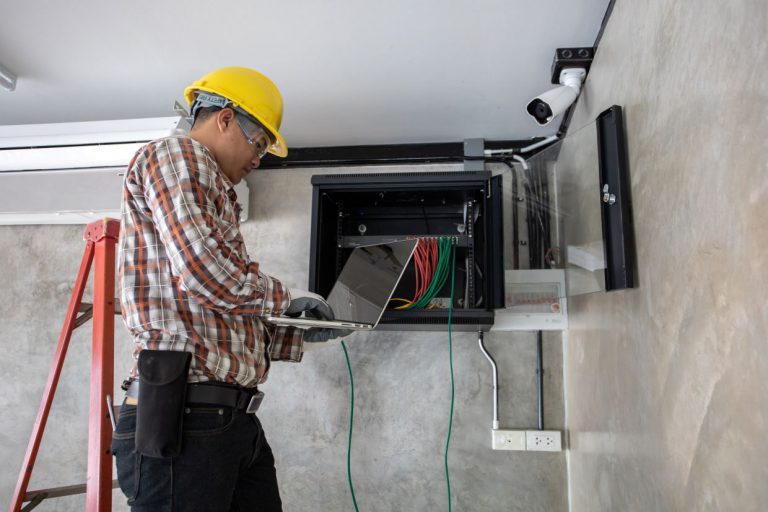Essential Guidelines for Successful Network Cabling Installation

- Maintaining a stable and efficient work environment in today’s fast-paced digital age requires robust Ethernet networks. They serve as the backbone of modern connectivity, enabling seamless communication, data sharing, and access to organization resources. To establish a strong Ethernet network, it’s essential to follow a series of steps that ensure the initial functionality of the network, as well as its long-term reliability and scalability. Let’s explore the fundamental aspects of network wiring installation, giving you valuable insights and guidelines for a successful implementation.
Basic Steps of Network Wiring Installation
To set up a functional network, start by creating a central hub that will house your router and networking switch. This hub will serve as the focal point of your network. You should then install outlets near the central hub and in any location where you plan to connect networked devices.
This will save time and avoid cable clutter. Next, run Ethernet cables through walls and ceilings to each outlet, making sure to avoid electrical conduits to prevent interference. Connect the cables at both ends securely to ensure a stable network. Fit the outlets with faceplates to give a neat, finished look. Before configuring your devices, always test each network connection to ensure they are working properly.
Do’s and Don’ts in Network Cabling Installation
Navigating the intricacies of network cabling installation can be challenging, but knowing the do’s and don’ts can significantly streamline the process. This section delves into essential best practices and potential pitfalls in network wiring, providing valuable insights to both novices and seasoned installers.
Whether you’re planning a DIY project or considering hiring a network cabling company, these guidelines will help you avoid common mistakes and ensure a successful installation.
What Not To Do
Avoid Unsafe Spaces
Always avoid running cables near electrical conduits and pipes to prevent hazards.
Don’t Bundle Wires Too Tightly
Proper cable bundling is vital; if it is too tight, you risk damaging the cables.
Don’t Overload Cable Racks
Avoid the risk of overheating by not stacking too many cables on a single rack.
Avoid Layering Different Cable Types
Best Practices
Cross Cables at Right Angles. Doing so minimizes interference and ensures better signal quality. Labeling cables is crucial for future maintenance and troubleshooting. Always test each cable to ensure its functionality before finalizing your network. Measure Cable Length Carefully. The “measure twice, cut once” rule helps avoid costly mistakes. Document the Process. Maintain a detailed network diagram for future reference.
How to Install Network Cable: A Step-By-Step Guide
Embarking on a network cabling installation project requires meticulous planning and execution. This step-by-step guide is designed to walk you through the essentials of network wiring, providing a clear roadmap from initial planning to final testing.
Select a location for your server
Choose a dedicated, climate-controlled space for optimal server performance.
Place nodes and measure cabling
Determine where network nodes will be placed and measure cabling accordingly.
Select and Collect Necessary Hardware
Collect all essential tools and hardware before beginning the installation.
Position wall plates and cut holes.
Choose the exact locations for wall plates and carefully cut holes in the walls.
Run cable through walls.
Use fish tape to help run cables through walls safely.
Test connection.
Once more, test the network connections for functionality.
Network configuration.
Configure all connected devices, including servers, routers, and computers.
Hazards of DIY Network Installation
While DIY projects can offer a sense of accomplishment, undertaking your own network cabling installation comes with its own set of risks. From improper cabling to structural damage, this segment aims to make you aware of the complexities involved and why you might consider hiring a professional network cabling company for your installation needs.
House fire. Improper installation can, in extreme cases, lead to house fires.
Damage to walls. Hasty installation may cause unnecessary damage to your walls.
Poor Cable Layout. A poorly planned network can lead to inefficiencies and future problems.
Choosing a Network Cabling Company
When it comes to establishing a solid and efficient network infrastructure, the complexities and potential hazards can be daunting. These challenges underscore the importance of entrusting this critical task to professionals who specialize in network cabling installation.
Choosing a reputable network cabling company like Unifier not only helps mitigate the risks associated with DIY installation but also ensures that you benefit from the latest industry standards and best practices. With a team of skilled network cabling installers, we can tailor a solution that meets the unique requirements of your organization, ensuring long-term reliability, scalability, and performance.
By trusting the experts, you’re investing in a robust, secure, and reliable network that will serve as the backbone of your organization’s digital operations for years to come.
Call us now for a free consultation and take the first step towards a better-connected future
